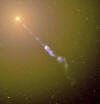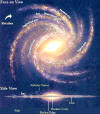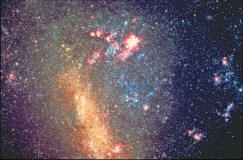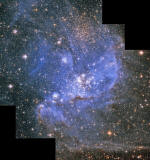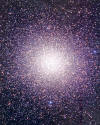|
from UniverseReview Website
The Milky Way (see below insert) is a member of the Local Group of galaxies, which in turn is a part of
the Virgo supercluster (see Figure 03-06). It is centered on the Virgo cluster and extends some 150 million ly across. The Virgo cluster itself contains thousands of galaxies including M87 (right), which is known to surround a gigantic black hole. Virgo's gravity affects the movement of its neighbors, including the Local Group. (below right)
The supercluster is the last outpost before a space traveler would enter a nearly galaxy-free region called a cosmic void. Actually, even the supercluster has a mass equaling some thousand trillion suns, virtually all its volume is empty in such a vast
space.
The Local Group of galaxies extends some 4 million ly (light years) across.
Most galaxies in the group
are considered dwarfs, but the two largest - the Milky Way and the
Andromeda galaxy
(left) - are giant
spirals. The galaxies of the Local Group are traveling together through
space - indicating a common origin. from UniverseReview Website
long exposure time, it appears like a silvery bridge across the sky as shown in Figure 05-11.
It is a view looking from inside the galactic disk. An all sky (panoramic) view is shown in Figure 05-12. If we could fly away from the Milky Way and look back, the view would be similar to the spiral galaxy NGC 3370 as depicted in Figure 05-13. Similar in size to our own Milky Way, spiral galaxy NGC 3370 lies about 100 million light-years away toward the constellation Leo. It contains a mixture of young stars in the bluer regions and an older population in the yellowish center.
The total mass of NGC 3370 and the Milky Way is estimated to be several 1011 solar mass. The main components of the Milky Way consist of a nucleus at the center, a nuclear bulge, a disk in the form of spiral arms winding around this nucleus, and a halo, which covers both the nucleus, the disk, and contains a spherical distribution of globular clusters (see below
insert) as shown in
Figure 05-14.
The radius of the visible disk is about 20 kpc with the Sun located 15
kpc from the center.
Figure 05-15 shows
the location of the various components within the Milky Way up to 100
kpc from the center.
by astronomers many years ago. It is observed that most galaxies formed from the merging of smaller precursors, and in the case of the Milky Way, we can observe the final stages of this process. As shown in Figure 05-16a, the Milky Way is tearing apart small satellite galaxies (such as the Large and Small Magellanic Clouds - click below images) and incorporating their stars. Meanwhile hot intergalactic gas clouds are continually arriving from intergalactic space. The evidence for the continuing accretion of gas by the Milky Way involves high-velocity clouds (HVCs) - mysterious clumps of hydrogen, up to 10 million solar mass and 10,000 ly across, moving rapidly (from 90 to 400 km/sec) through the outer regions of the galaxy. These materials form the reservoir from which the Milky Way can draw on to make new stars.
The disk of the Milky Way exhibits a spiral structure, which shows up in the distribution of objects populating the disk component. These objects include, the HI regions of neutral hydrogen atoms, the population I objects such as young stars, diffuse star-forming nebulae, H II regions of ionized hydrogen atoms and open star clusters (right). These population I objects are very young, in contrast to
the very old population II objects in the Milky Way's Halo (globular clusters and old stars, including older planetary nebulae). The arms of the Milky Way, at least near the solar neighborhood in our Galaxy, are typically named for the constellations where more prominent parts of them are situated.
The solar system is trundling around at nearly 200 km/sec in the Local or Orion Arm - a spur in between the more substantial Sagittarius and Perseus arms. The Milky Way is now known as a barred spiral. The evidence, at first indirect, began to accumulate in 1975: stars and gas tracked in the middle of the Milky Way did not follow the orbits they would if the spiral pattern reached all the way in. Recent surveys of the sky in near-infrared light have revealed the bar directly and dispelled the remaining doubts (Figure 05-16b)
from UniverseReview Website
The stars in Omega Centauri are all very old, about 12 billion years. They are packed so densely in the cluster's core that it is difficult for ground-based telescopes to make out individual stars.
Those in the core of Omega Centauri are so densely packed that occasionally one of them will actually collide with another one. Even in the dense center of Omega Centauri, stellar collisions will be infrequent. But the cluster is so old that many thousands of collisions must have occurred. When stars collide head-on, they probably just merge together and make one bigger star.
But if the collision is a
near miss, they may go into orbit around each other, forming a close
binary star system. Omega Centauri is the most luminous and massive
globular star cluster in the Milky Way. It is one of the few globular
clusters that can be seen with the unaided eye.
|
